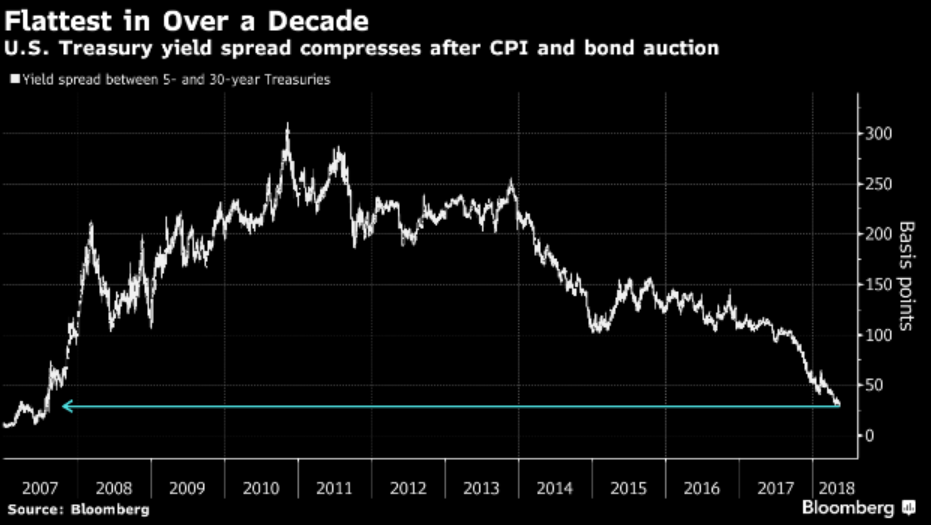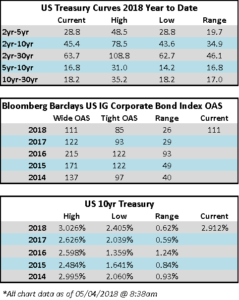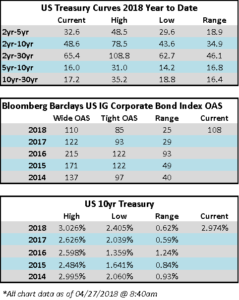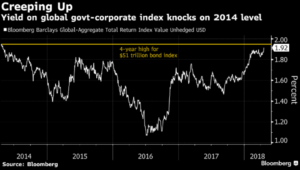Fund Flows & Issuance: According to a Wells Fargo report, flows week to date were -$0.8 billion and year to date flows stand at -$26.5 billion. New issuance for the week was $1.6 billion and year to date HY is at $84.8 billion, which is -23% over the same period last year.
(Bloomberg) High Yield Market Highlights
- Despite all the hullabaloo about rising rates, U.S. high yield investors bought three CCC-rated deals in the primary, led by Valeant.
- Valeant dropped a senior secured tranche, increased size of a term loan
- Bond priced at tight end of talk, received orders of more than $5.5b
- SRS Distribution and Hearthside funded aggressive buyouts by private equity
- Investors showed restraint, demanding appropriate risk premia
- Both deals priced at wide end of talk
- Both made material covenant changes to strengthen investor protection
- Investors ignored outflows from retail funds
- CCCs beat BBs and single-Bs with a return of 2.03% YTD
- IG’s YTD return is negative 4.15%
- Lack of supply, combined with low default rate and decent corporate earnings, boosts risk-on sentiment for junk bonds
- High yield is expected to be tested in the second half of the year by supply from Blackstone funding the buyout of financial and risk businesses from Thomson Reuters, Carlyle Group funding for acquisition of specialty chemicals business from AkzoNobel
(Multichannel News) Charter’s Enterprise Unit Earmarks $1B-Plus for Fiber Plan
- Spectrum Enterprise, a unit of Charter Communications focuses on the large business services segment, said it will invest more than $1 billion in 2018 to increase the density of its national fiber network.
- Charter said this will be the second straight year in which the company has invested in excess of $1 billion exclusively in Spectrum Enterprise, which will be looking to expand on a network of nearly 200,000 fiber-lit buildings.
- Spectrum Enterprise will absorb the bulk of the upfront costs of fiber construction for most new enterprise clients in its footprint for solutions such as Fiber Internet Access, Ethernet and voice trunks.
- The investment will also come to add fiber density as wired networks become a significant backhaul channel for a coming wave of 5G-based services and other bandwidth-intensive offerings.
- “As fiber connectivity has become fundamental to economic growth, we are focused on making our fiber infrastructure more accessible to clients, and reshaping their experience to align with the evolving realities of today’s modern enterprise,” Phil Meeks, EVP and president of Spectrum Enterprise, said in a statement. “Advanced video and virtual reality solutions, cloud, IoT and the future of 5G all depend on a reliable and highly-dense fiber network. Our commitment is to ensure that our clients have the most robust fiber network and solutions to grow today and take advantage of future technologies that have immense demands on bandwidth.”
(PR Newswire) Steel Dynamics to Acquire CSN Heartland Flat Roll Operations
- Steel Dynamics, Inc. announced that it has entered into a definitive agreement to acquire Heartland from CSN Steel, S.L.U., a wholly-owned subsidiary of Companhia Siderurgica Nacional. Located in Terre Haute, Indiana, Heartland produces various types of higher-margin, flat roll steel by further processing hot roll coils into pickle and oil, cold roll, and galvanized products. Steel Dynamics has agreed to purchase Heartland for $400 millionin cash inclusive of $60 million of normalized working capital, subject to customary transaction purchase price adjustments. Steel Dynamics believes the purchase price approximates current replacement value. The transaction is expected to be accretive to near-term earnings and cash flow per share. The acquisition will expand Steel Dynamics’ annual flat roll steel shipping capacity to 8.4 million tons and total shipping capability to 12.4 million tons. The additional exposure to lighter-gauge and greater width flat roll steel offerings will broaden the Company’s value-added product portfolio, enhancing Steel Dynamics position as a leading North American steel producer.
- “The acquisition of Heartland represents a step in the continuation of our growth strategy,” said Mark D. Millett, Chief Executive Officer. “It levers our core strengths, and at the same time fulfills our initiatives to further increase value-added product and market diversification. We look forward to welcoming the Heartland employees and customers into the Steel Dynamics family, and working with them to drive future growth and success.
- “We have positioned our capital structure and organizational framework for growth,” continued Millett, “and we believe this acquisition will result in numerous future earnings benefits both to Heartland’s current operations and to our Midwest flat roll operations. In combination with our current operations, Heartland brings a tremendous amount of operating flexibility and optionality. As a part of our broader business platform, Heartland is expected to provide numerous synergies with our existing operations, and we look forward to levering these opportunities in the future.”
(Bloomberg) Teva Rises After Berkshire Hathaway Boosts Stake in Drugmaker
- Teva Pharmaceutical shares rose after Warren Buffett’s Berkshire Hathaway Inc. more than doubled its stake in the struggling Israeli drugmaker, a vote of confidence in Chief Executive Officer Kare Schultz’s turnaround effort.
- Berkshire Hathaway owns 40.5 million American depositary receipts in Teva, Buffett’s company said in a regulatory filing Tuesday. The Omaha, Nebraska-based company made its initial investment in Teva last year.
- Saddled with debt, Teva has been cutting its workforce and closing factories to cut costs. The company this month raised its 2018 profit forecast as Schultz’s belt-tightening program begins to take hold. Teva has been hurt by falling margins on knockoff drugs and rapidly declining sales for its best-selling product, the multiple sclerosis drug Copaxone.
- Buffett, 87, has handed some of his stock-picking duties to Todd Combs and Ted Weschler, who together oversee about $25 billion. Berkshire hired Combs in late 2010 and Weschler about a year later. Buffett said in February that the Teva investment was made by one of his deputy stock pickers and he didn’t know the reasoning behind the decision.
(CNBC) Williams to buy rest of Williams Partners in $10.5 billion deal
- Pipeline operator The Williams Cos. said on Thursday it would buy the remaining 26 percent stake that it does not already own in its master limited partnership, William Partners, for $10.5 billion. Williams would give 1.494 of its shares for each share of Williams Partners, with the offer representing a premium of 6.4 percent based on Wednesday’s closing price.
- The company said the deal will immediately add to cash available to dividends extending the period for which the company is not expected to be cash taxpayer through 2024.
- The deal simplifies Williams’ corporate structure, streamlines governance and maintains investment-grade credit ratings, the company said.
- (CAM Note) Moody’s and Fitch has moved the debt of Williams Companies to under review for upgrade on the news.





